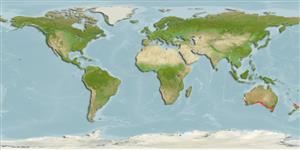Environment: milieu / climate zone / depth range / distribution range
Écologie
marin; saumâtre récifal; profondeur ? - 90 m (Ref. 9563). Temperate; 26°S - 43°S
Indo-Pacific: Endemic to Australia.
Taille / Poids / Âge
Maturity: Lm ? range ? - ? cm
Max length : 50.0 cm TL mâle / non sexé; (Ref. 7300)
Description synthétique
Clés d'identification | Morphologie | Morphométrie
Épines dorsales (Total) : 9; Rayons mous dorsaux (Total) : 14 - 15; Épines anales: 3; Rayons mous anaux: 14 - 15; Vertèbres: 26. Adults are silver to brown with black vertical stripes (Ref. 33616).
Juveniles live in estuaries (Ref. 33616) while adults occur in estuaries and on inshore and offshore rocky reefs and seagrass beds (Ref. 9563). Found either in large schools, in pairs or as solitary individuals (Ref. 33616). Neither anterolateral glandular groove nor venom gland is present (Ref. 57406). Reported to have venomous fin spines without associated venom gland (https://fishesofaustralia.net.au/home/species/445#moreinfo).
Life cycle and mating behavior
Maturité | Reproduction | Frai | Œufs | Fécondité | Larves
Paxton, J.R., D.F. Hoese, G.R. Allen and J.E. Hanley, 1989. Pisces. Petromyzontidae to Carangidae. Zoological Catalogue of Australia, Vol. 7. Australian Government Publishing Service, Canberra, 665 p. (Ref. 7300)
Statut dans la liste rouge de l'IUCN (Ref. 130435: Version 2024-1)
Menace pour l'homme
Venomous
Utilisations par l'homme
Pêcheries: intérêt commercial mineur; Aquarium: Commercial
Outils
Articles particuliers
Télécharger en XML
Sources Internet
Estimates based on models
Preferred temperature (Ref.
123201): 15.3 - 20.6, mean 17.7 °C (based on 232 cells).
Phylogenetic diversity index (Ref.
82804): PD
50 = 1.5000 [Uniqueness, from 0.5 = low to 2.0 = high].
Bayesian length-weight: a=0.00389 (0.00180 - 0.00842), b=3.12 (2.94 - 3.30), in cm total length, based on all LWR estimates for this body shape (Ref.
93245).
Niveau trophique (Ref.
69278): 3.3 ±0.40 se; based on food items.
Fishing Vulnerability (Ref.
59153): Moderate vulnerability (40 of 100).
Nutrients (Ref.
124155): Calcium = 17.9 [7.0, 29.5] mg/100g; Iron = 0.206 [0.104, 0.363] mg/100g; Protein = 19.1 [18.0, 20.2] %; Omega3 = 0.243 [0.127, 0.478] g/100g; Selenium = 11 [5, 27] μg/100g; VitaminA = 30.6 [7.8, 118.3] μg/100g; Zinc = 0.744 [0.478, 1.193] mg/100g (wet weight);
